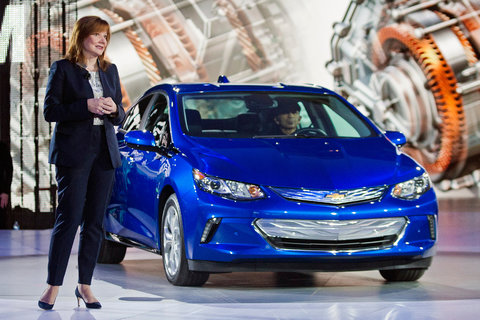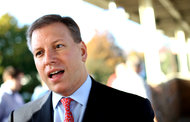|


Hedge Fund-Backed
Investor Puts Himself Up for G.M. Board
By
Michael J. de la Merced
and
Bill Vlasic
February
10, 2015 9:37 am
|

Mary Barra, chief executive of
General Motors.
Credit Tony Ding/Associated Press.
|
Updated, 9:28 p.m. |
Six years
ago, Harry J. Wilson was enlisted by the Obama administration to help
overhaul General Motors as part of a taxpayer-financed bailout.
Now,
the former Goldman Sachs financier is trying to change the automaker
once again — but this time with four big hedge funds on his side.
On Tuesday,
Mr. Wilson put himself up for a seat on the G.M. board, as part of a
campaign to persuade the company to buy back at least $8 billion worth of
shares by next year.
The
potential board fight is the latest corporate challenge for General Motors
as it wrestles with the biggest safety crisis in its history and the recall
of tens of millions of vehicles.
While the
company has regained financial strength since the bailout and its return to
the public markets in 2010, some investors have complained that it has done
little for them.
Backing Mr.
Wilson are big hedge fund magnates like David A. Tepper of Appaloosa
Management and J. Kyle Bass of Hayman Capital Management. (Mr. Bass has been
calling for big share buybacks for months.) All told, the investors own a
stake of roughly 2 percent. As part of their arrangement, Mr. Wilson will
receive a share of the profits that the investment generates.
Shares of
General Motors rose more than 4 percent on Tuesday.
| |

Harry J. Wilson, a former member of the
Obama administration’s auto task force, runs the restructuring
business Maeva.
Credit Craig Ruttle for The New York Times
|
In an
interview, Mr. Wilson conceded that the company had made huge strides since
the bailout, particularly in changing a corporate culture he derided as
broken. But under a succession of leaders, including its current chief
executive, Mary T. Barra, the automaker has presided under a largely
moribund stock price.
“There’s
been growing frustration that’s been coming together,” he said. “We want to
help the company go from where it is today to where it should be, a
world-class performer on any metric.”
Since its
bailout, General Motors has steered a conservative financial course. It has
argued that it needs what it has called a “fortress balance sheet,” one that
includes $25 billion in cash on hand.
Some of that
money has gone toward the costs of the safety crisis. For more than a
decade, company officials knew about but failed to fix defective ignition
switches in millions of small cars. To allay fears that it was neglecting
safety issues, General Motors issued more than 80 recalls last year covering
nearly 30 million vehicles. It spent about $3 billion in 2014 to compensate
accident victims, fix recalled cars and trucks, and reorganize its vast
engineering operations and safety teams.
The recalls
took a heavy toll on G.M.’s bottom line. Last week, the company reported net
income for 2014 of $2.8 billion, a 31 percent drop from $3.99 billion the
previous year.
In a
statement, General Motors said that it would evaluate both of Mr. Wilson’s
proposals. It added that it had recently announced plans to raise its
quarterly stock dividend by 20 percent and would announce other plans to pay
out to investors in due course.
But Mr.
Wilson, 43, argued that the company had been too conservative in the
handling of its finances and had failed to improve on other financial
metrics, like operating margin. He said that he had publicly warned G.M.
about the potential of an activist investor emerging as early as the fall of
2013.
Last month,
he approached Ms. Barra at an investor conference, telling her that he had
ideas to share. When they met last week, he laid out several initiatives
aimed at bolstering operating performance and paying out more to
shareholders. He also disclosed that he wanted a seat on the board to serve
as a representative for shareholders.
Though
G.M.’s statement suggested that Mr. Wilson’s move was sudden, he contended
in an interview that he had tried three times to extend the deadline for
nominating directors beyond Monday night at midnight.
An industry
analyst said in a research note that the company might decide on a smaller
buyback than Mr. Wilson and his investment group have requested.
“G.M. still
needs to work through recall litigation and the U.A.W. negotiations,” Andrew
Smith, an analyst with Barclays, said, referring to the United Automobile
Workers union. “However, we believe there is a fair likelihood that G.M.
enacts some sort of share buyback (perhaps $4 billion) to show investors
that it is enhancing shareholder value.”
In some
ways, Mr. Wilson’s move harkens back to the beginnings of his career as a
financier. Before he joined the Obama administration’s auto task force, he
had worked at Goldman Sachs and the hedge fund Silver Point Capital, where
he became an expert on investing in distressed companies.
During his
time in Washington, he served as the team leader for G.M., supervising the
overhaul of the automaker. It was Mr. Wilson who helped devise the
administration’s tactic to lend the company the billions of dollars it
needed to stay afloat during bankruptcy in exchange for a stake that would
be sold down over time. (The government sold the last of its shares at the
end of 2013.)
Since
leaving the task force, Mr. Wilson ran, unsuccessfully, as the Republican
candidate for New York State comptroller before setting up the Maeva Group,
a corporate turnaround consulting firm. That latest phase of his career has
put him in touch with several notable activist investors, including the
billionaire Daniel S. Loeb, who had him installed on the boards of Yahoo and
the art auction house Sotheby’s.
Even six
years after the auto bailouts, however, Mr. Wilson has remained bothered by
how slowly G.M. has been recovering, according to people close to him.
“Harry’s a
perfectionist,” said one acquaintance. “It was frustrating him that G.M.
wasn’t getting A-pluses across the board.”
Mr. Wilson
himself did not shy away from the classroom metaphor in discussing how much
room G.M. has to improve.
“They went
from a big red ‘F’ before the crisis to much better performance, but they’re
not at the ‘A’ they’re capable of,” he said. “I think Mary has the potential
to get them there, but I think she needs some help.”
Copyright 2015
The New York Times Company |


